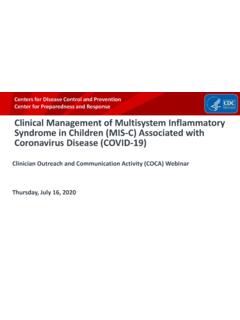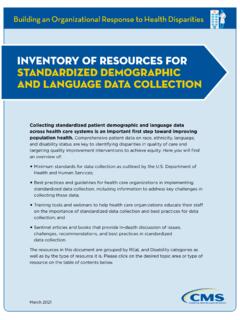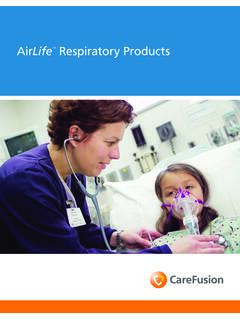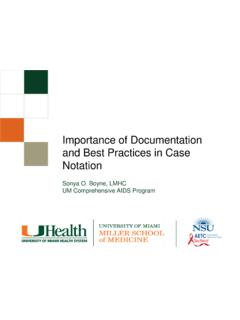Transcription of Chapter 8 Community Tuberculosis Control
1 Chapter 8: Community Tuberculosis Control227 Table of ContentsChapter Objectives .. 227 Introduction .. 229 Roles and Responsibilities of the Public Health Sector Providers .. 229 Roles and Responsibilities of Specific Private Health Sector Providers .. 236 Chapter Summary .. 247 References .. 248 Chapter ObjectivesAfter working through this Chapter , you should be able to Describe the roles and responsibilities for Tuberculosis (TB) Control and prevention in the public health sector; and Describe the roles and responsibilities for TB Control and prevention in the private health 8 Community Tuberculosis ControlChapter 8: Community Tuberculosis Control229 IntroductionState and local health departments have the primary responsibility for preventing and controlling TB.
2 However, TB Control is a complex undertaking and requires the collaborative efforts of a broad range of persons, organizations, and institutions both inside and outside the public health sector. These various persons and organizations have a role in improving the detection of TB cases, one of the most important responsibilities of TB Control , and include Clinicians; Community health centers; Hospitals; Academic institutions; Medical professional organizations; Community -based organizations; Correctional facilities; Civil surgeons; and Pharmaceutical and biotechnology and local health departments have the primary responsibility for preventing and controlling Tuberculosis (TB).
3 Roles and Responsibilities of the Public Health Sector ProvidersThe essential role of the public health sector in TB Control is to plan, coordinate, and evaluate TB Control and prevention efforts. This role requires that state and local health departments focus and provide oversight on the following critical elements: Planning and policy development; Contact investigation; Clinical and diagnostic services for patients with TB and their contacts; Training and education; Surveillance data and information management ; and Monitoring and essential role of the public health sector in TB Control is to plan, coordinate, and evaluate TB Control and prevention 8: Community Tuberculosis Control230 Planning and Policy DevelopmentState and local TB Control programs have the responsibility for developing TB Control policies and procedures.
4 A TB Control plan should be developed in collaboration with Community stakeholders and experts in medical and nonmedical TB management . Laboratory directors and professional organizations also make excellent partners to collaborate with when developing TB Control policies. A TB Control plan should be developed in collaboration with Community stakeholders and experts in medical and nonmedical TB plan should be based on an understanding of local epidemiologic data and on the capabilities and capacities of clinical and support services for clients.
5 Fiscal resources available for TB Control also determine the plan s scope and direction, as well as ongoing indicators of program performance (program evaluation). Policies and procedures should reflect national, state, and local standards of care and should offer guidance in the management of LTBI and TB disease. A written TB Control plan should be updated regularly and distributed widely to partners. The TB Control plan should Assign specific roles and responsibilities; Define essential pathways of communication between providers, laboratories, and the public health system; Assign sufficient resources, both human and financial, to ensure its implementation, including a responsible case manager for each suspected and verified case of TB disease; Provide provisions for expert consultation and oversight for TB-related matters to clinicians, institutions, and communities.
6 Provide special guidance to local laboratories that process TB-related samples; Assist local authorities in conducting contact or outbreak investigations and directly observed therapy (DOT); and Provide culturally appropriate information to patients, persons at risk, and the written TB Control plan should be updated regularly and distributed widely to to minimize or eliminate financial and cultural barriers to TB Control should be integral to the plan. Persons with TB disease and persons at high risk for TB should receive culturally appropriate education about TB and clinical services, including treatment, without consideration for their ability to pay.
7 The plan should be consistent with current legal statutes related to TB Control . Relevant laws and regulations should be reviewed periodically and updated as necessary to ensure consistency with currently recommended clinical and public health practice ( , mandatory reporting laws, institutional infection Control procedures, hospital and correctional system discharge planning, and involuntary confinement laws). The health department is legally responsible for ensuring that Chapter 8: Community Tuberculosis Control231a complete and timely contact investigation is done for the TB cases reported in its jurisdiction.
8 Health departments should work closely with providers in the nonpublic health sector to ensure prompt reporting of suspected TB cases. They should understand the public health aspects of TB, including the need for prompt reporting and the facilitating role of the jurisdictional health agency in case management . Federal agencies should take the lead in resolving interstate TB- Control issues, including movement of TB patients across state lines and multistate TB outbreaks. The health department is legally responsible for ensuring that a complete and timely contact investigation is done for the TB cases reported in its area.
9 Health departments should work closely with providers in the nonpublic health sector to ensure prompt reporting of suspected TB cases. Clinical and Diagnostic Services for Patients with TB Disease and Their ContactsTB Control programs should ensure that patients with suspected or confirmed TB disease have ready access to diagnostic and treatment services that meet national standards. These services are often provided by state and/or locally supported TB specialty clinics and staffed by health department personnel or by contracted service providers.
10 However, persons may seek medical care for TB infection or disease in the private medical sector. Regardless of where a person receives medical care, the primary responsibility for ensuring the quality and completeness of all TB-related services rests with state and local public health agencies. To ensure that standards of care are met, health departments should develop and maintain close working relationships with Local laboratories; Pharmacies; and Health-care of where a person receives medical care, the primary responsibility for ensuring the quality and completeness of all TB-related services rests with state and local public health facilities should provide screening, diagnostics, and monitoring tests, including radiology services include access to radiograph equipment, trained radiograph technicians, and radiograph interpretation by a qualified person.
















